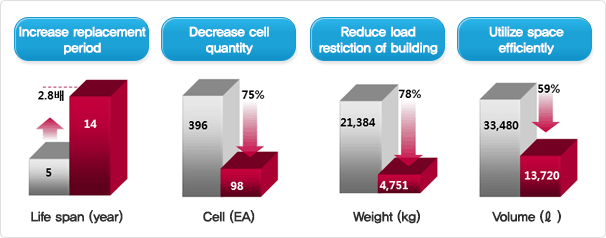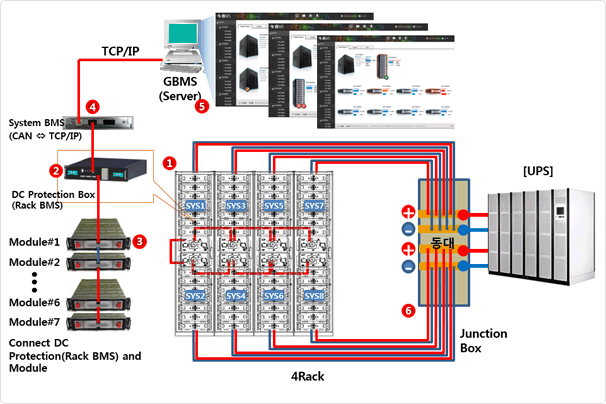Business Field > Environment/Energy > ESS


- Comparison of lithium-ion battery
It has higher volume/weight energy density than other secondary batteries and saves weight and space with its excenllent charging/discharging characteristics
| Classification | Year of commercial production | Volume energy density (Wh/L) |
Weight energy density (Wh/Kg) |
Voltage (V) |
Charging count (times) |
Environment regulation (Substance) |
|---|---|---|---|---|---|---|
| Lithium | 1991 | 200~500 | 75~250 | 3.7 | 5,000 and more | None |
| Nickel metal hydride | 1990 | 170~350 | 40~110 | 1.2 | 500~1,000 | None |
| Nickel-cadmium | 1964 | 60~200 | 20~70 | 1.2 | 500 and more | Cadmium |
| Lead | 1859 | 50~80 | 20~40 | 2 | 400~1,000 | Lead |
- Advantage to apply lithium-ion battery to UPS
UPS system requirements: Comparison based on 500KVA, nominal voltage 384V, 30 minutes of backup time
| UPS system requirements | 500KVA(Emerson), 20 minutes of backup time | |
|---|---|---|
| Battery | LGC LiPB | Global Battery |
| Specifications of battery system | UPB4860 | ESC 900Ah |
| Cell type | Polymer | Lead storage battery |
| Pack size | 554(L)×445(W)×122(H) | 471(L)×171(W)×362(H) |
| Battery system configuration | 98 Pack (49Pack/Set) | 396 Cell |
| Battery weight (excluding Rack and electrical device) | 39.5kg×98 Pack = 3,871kg | 54kg×396 = 21,384kg |
| Weight of battery system | 4,751kg | 21,384kg (weight of lead storage batter) |
| Durability | 10~14 years | 5 years |
| Monitoring system | Provide information regarding real time battery status and poeration of protective function | None |
| System area | 2.4×2.6=6.24(m2) | 3.1×4=12.4(m2) |
| System volume | 2.4×2.6×2.2=13.72(m3) | 3.1×4×2.7=33.48(m3) |


- ① Rack: System for installing lithium-ion battery based on 19" standard rack
- ② DC Protection Box: Perform the protective function of lithium-ion batteries connected in series
- ③ Lithium polymer battery: As 19” module type, provide the capacity of 3.2KW (48V 60Ah)
- ④ BMS(Battery Management System): Provide information regarding lithium-ion batteries
(voltage/electric current/temperature/capacity, etc) - ⑤ GBMS: Provide the function to display and monitor information from BMS in GUI form
- ⑥ Junction Box: Collect power from the battery rack and send to UPS
| Year | Project Name |
|---|---|
| 2013 |
- ESS distribution project of Korea Smart Grid Institute in 2013 - SK Apartment-type Factory (750KW/550KWh) - JungangInduspiaCo. Apartment-type Factory ((500KW/250KWh) - ESS distribution project of Korea Energy Management Corporation in 2013 - Korea Institute of Energy Research (500KW/250KWh) - Korea District Heating Corporation (500KW/250KWh) - ChungbukNational University Hospital (270KW/250KWh) |
| Representative | Field of Concentration / Profession | TEL | |
|---|---|---|---|
| Seung-yeub, Lee | Lithium-ion Batteries for Uninterruptible Power Supply (UPS) & Rectifier Systems | sylee11g@gsneotek.co.kr | +(82) 2-2630-5122 |
| Ki-yong, Yoo | Lithium-ion Batteries for Uninterruptible Power Supply (UPS) & Rectifier Systems | wj730730@gsneotek.co.kr | +(82) 2-2630-5186 |
Plant - Environment/Energy - Electric Machinery - Information & Communications - IT
















































 >
>

